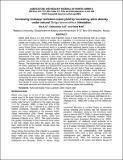Increasing imazapyr-resistant maize yield by increasing plant density under natural Striga hermonthica infestation
Abstract/
Maize (Zea mays L.) is one of the most important crops in East Africa serving both as a staple
food and cash crop to millions of people. As a vegetable, it is produced as green maize cobs,
sweet corn or baby corn. Yields under farmers’ conditions in the Lake Victoria Basin average 1.3 t
ha-1 which is less than 25% of the potential yield. This is attributed to several factors; the greatest
being Striga (Striga hermonthica) which is a parasitic weed attacking several crops in the grass
family. A medium-term technological breakthrough in form of a herbicide (imazapyr) resistant
maize variety has been developed to help reduce Striga infestation. The optimum maize plant
population for effective seed bank reduction and optimum grain yield has however not been
determined. The main objective of this study was, therefore, to evaluate the performance of
imazapyr-resistant (IR) maize at different plant densities on Striga weed incidence and crop
growth. The study was conducted for two seasons on a naturally infested Striga field in Western
Kenya. The experiment was laid out as a split plot with three replications. Maize variety (treated
IR maize, untreated IR maize and WH505/H516 commercial checks) was the main plot factor and
density (44,444, 66,666 and 88,888 plants ha-1) as the subplot factor. Data was collected on
maize stand, days to first Striga emergence, Striga incidence, Striga biomass, maize biomass
and its yield components. Treated IR maize delayed Striga emergence on maize thus
suppressing Striga parasitism. Any late Striga attachments had little or no effect on maize growth.
Increasing the plant density of treated IR maize from 44,444 to 88,888 plants ha-1 did not affect
Striga incidence but increased maize yield from 1.60 to 3.48 t ha-1. It is therefore recommended
that treated IR maize should be planted in Striga infested fields at 75cm x 15cm to hasten Striga
seed bank reduction and maximize on maize yield to improve staple food availability

